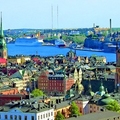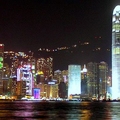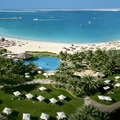Destinations / The best capital cities in the world / Tirana-a capital to remember
Tirana-a capital to remember
About Tirana
Tirana is the capital of the Republic of Albania and the main political, economic and cultural center of the country. The city forms an independent administrative unit, as well as the administrative center of the area and of Tirana district. The city has an area of 30 km ². It was founded in 1614 and it became the capital of the country in 1920. Being a small but compact city, the best method of exploration is walking. The architecture of the city is largely represented by monuments and constructions in Italian and Turkish style, it is so due to the city's geographic position mid way between Istanbul and Rome, an amalgam of influences from both cultures.
The further development and the establishment of the Tirana city was made possible due to its geographical position, fertile land, rich forests and water, at the crossroads between the Adriatic and the eastern Albania, along with the Qafa e K `Rab Valley and the Shkubin River. The gray and the boring old town has radically changed. It became a city full of life and color in the last decade . Tirana is still rapidly growing . It became a commercial and administrative center with several comfortable hotels, restaurants, discos, pubs and modern facilities for conventions and conferences.
History of Tirana
There was a settlement since time immemorial in the place of the present city. It was first mentioned in sources in the XV century as a small settlement. The 1614 year is considered the founding year of Tirana. Suleiman Pasha Bargiyni founded a mosque , the Turkish baths , a bakery and several stores . The advantageous location at the crossroads of the trade routes contributed to its development. In the XVII century there was already a famous bazaar of merchants , trading silk , spices , ceramics and precious metals. Tirana has always been an arena of struggle of the Albanian people against the Turkish invaders and the local feudal lords. In January, 1920 by decision of the Albanian National Congress Lyushne proclaimed Tirana capital in Albania and the seat of the government. In the 20's, the first trade unions appeared in Tirana. In April 1939 - September 1943 Tirana was occupied by the fascist Italy , in September 1943 by the Nazi Germany . It was one of the centers of the national liberation struggle of the Albanian people. In November1941 in Tirana was founded the Communist Party of Albania. On November 17, 1944 the city was liberated from the Nazi invaders with the help of the National Liberation Army. On January 11, 1946 Tirana was proclaimed the Republic of Albania. A number of modern enterprises, many cultural institutions were set up in Tirana in 1950 by the USSR and by the other socialist countries.
Economy of Tirana
Tirana is the main industrial center in Albania. There is a rapid economic development and many new industries created here since 1920. The major industries include agricultural products and equipment, textiles, pharmaceuticals, and metal products. Tirana began to develop in the early XVI century, when the market was created, and its master of silk and cotton textiles, leather, ceramics and iron, silver, gold and artifacts were highly demanded on the market . Located in a fertile plain, the Tirana area exported 2600 barrels of olive oil and 14,000 packages of tobacco in Venice in 1769. In 1901, it had 140 000 olive trees, 400 oil mills, and 700 stores. The TID Tower of 85 meters was built in the city. It will review the architecture in Albania, the Tyrants and the huge shopping centers, such as a city park of 3 km ².
Industry of Tirana
Tirana focuses much on the country's industrial production. Textiles, food processing, tobacco, footwear, metal, glass and ceramic industry are developed here. Among the largest companies are: the Textile Mill, mechanical plant, woodworking, footwear and tobacco factories, meat-packing plant, distillery and dairy plant, the factory of furniture, cement plants and plant materials, plant parts for tractors, coal factory briquettes; numerous workshops producers' cooperatives, CHP. The industrial enterprises are located mainly in the western and in the south-western part of the capital. There are coal mines in the Tyre area , Krraba and Prisca. In1951 , near Tirana, with the assistance of the Soviet Union , the first hydroelectric power station was built . The city is supplied with water to the turbines from the mountain source of the Selita river to the city. Tirana railway line is connected to the port of Durres and the city of the mantle , highways through the city of Elbasan , Kruyu and Durres with other cities of Albania. Tirana is located near the Rinas Airport .
Climate
Tirana is located in the intermountain valley (at an altitude of 89 m above the sea level) along the river Ishm in the central plains of Albania at the foot of the mountain range Kruja-Daichi, 40 km from the Adriatic Sea . The climate is subtropical and Mediterranean. Summers are usually hot and dry with an average July temperature of 24 ° C, and winters are mild and humid with average January temperatures of 4-5 ° C. The daily fluctuations are large enough, they range from 10 ° C in January to 14-15 ° C in July. The average rainfall is of 1376 mm per year. The ethnic composition The population of Tirana, according to the official data, in 2010 was of 386 420 inhabitants, according to unofficial data it was about a million people (11 thousand inhabitants in 1923 , 40 thousand inhabitants in 1939 , 108 thousand inhabitants in 1955 , 136.3 thousand inhabitants in 1960 , over 200 thousand people in 1975 .
The Administration of the city
Tirana is the city of subordination and the administrative center of the Tirana area. The public authority consists of the city People's Council, elected for three years by the citizens who are over 18 years. The People's Councils are elected in the urban areas of Tirana. The People's Councils elect the executive and the administrative bodies - the executive committees.
Architecture
The disposition of Tirana architecture is radial-circular. The older neighborhoods have narrow crooked streets and houses in the yard. The administrative and cultural centers had been built in the 1920 - 30 –ies: the Skanderbeg Square Ensemble, the bank, the university, the opera and ballet, the Efem Bay Mosque . In 1953 - 58 a plan of reconstruction of Tirana was adopted by G. Strazimiri, M. Mele architects. Extensive residential complexes, the studio "New Albania" were created in 1952 by the Soviet architect G. Lavrov.
Main sightseeing places of Tirana
The main objectives are: the Kalaja Fortress in Tirana, the Tirana Mosque, a monument of historical value, in harmony with the Clock Tower, with which it forms a complex value of the town church Shengjin; the Tabakeve Bridge - monument of Tirana, Tirana Ensemble monuments in the center, the Skanderbeg Square, the statue of Skanderbeg, where the National History Museum is.
The Skanderberg Square
The Sheshi Skenderbej is the main square in Tirana. Basically being a huge asphalt surface during the Second World War, it was big but the Communists expanded it further, a process in which they demolished the old bazaar. Beginning with 1958, the imposing Palace of Culture was built under the supervision of the communists. But after the deterioration of the relations between Albania and the Soviet Union, the chief engineer took all the projects and left Albania. The Albanian government hired a Chinese team to complete the project. Today the building houses the Opera and the National Library.
The Statue of King Skandenberg
Mr. Gjergj Kastrioti (1405-1468), known as Skanderberg in English Skenderbej in Albanian is the historical personality that all the Albanians consider as a national hero. He created an independent Albania, a status that managed to keep it for 25 years. After his death, Albania was occupied by the Ottoman Empire, but he maintained the legacy of the state identity intact for 500 years of Turkish domination. The Albanians consider him not only the father of the nation , but the one who saved the whole Europe from the Ottoman rule.
The Et'hem Bey Mosque
Wonderful and beautiful Et'hem Bey Mosque is one of the most interesting attractions in Tirana. The construction of the mosque was called “Xhamia is Haxhi Ethem Beut” . It began in 1794 and it was finalized in 1821 by Et'hem Bey. The mosque is located on the main city square. Having been closed during the communist regime, the mosque was reopened as a place of worship in 1991, but without permission from the authorities. They attended the reopening of 10,000 people, marking an important milestone in the rebirth of the religious freedom in Albania.
The National Museum of History
You shouldn’t avoid to see this museum because you will miss a sensational sight with its huge mosaic on the facade. The mosaic scenes embody the history of Albania representing the historical figures and supporters of the communist regime. Inside the building, each section of the museum presents the history stages of the Albanian people. Although it was often robbed in the '90s, the museum is still the best place where you can admire archaeological findings from all over Albania.
Educational Institutions
The Tirana University, The Institute of Agriculture, The Institute of Fine Arts, The Institute of Physical Education, Scientific institutions , The Albanian Academy of Sciences, The central research station, The Veterinary Research Institute, The National Library.
Museums
The Museum of Archaeology and Ethnography, The Museum of the struggle for national liberation, The Natural Science Museum, The Museum of Lenin and Stalin.
Theaters
The Opera and Ballet Theatre (from the ballet scool), The People's Theatre, The Variety Theatre and circus, The Puppet Theatre.
Institutions of Culture and Art
The Conservatory, The Philharmonic, The Graduate Acting School" A. Moses", The Art Lyceum ” I. Moissi “, The Film Studio "New Albania".
The Revival of Tirana
The city experienced a radical change at the turn of the millennium. In 2000, the city government launched a campaign to brighten and liberate the public space that was previously occupied by a mass of illegal commercial establishments. The campaign, called " The Return to Identity" , included the return of the river banks, parks and other public bodies in their state before 1990.The overall infrastructure has improved, since a significant number of roads have been reconstructed. Most of the parks and gardens have been rescheduled to give the city a more "European" look. Open spaces between apartment buildings undergone a big redevelopment, the illegal structures were demolished and replaced by planted gardens and parks. However, a number of vacant lots, intended for planting, were given a construction site. Residential houses had been built on a foundation of house demolitions. The Mayor of Tirana, Edi Rama offered to paint the facades of buildings in bright colors, while the buildings themselves gradually were deteriorated.
Tirana Capital
On February 8, 1920 the Albanian National Congress, was chosen as the temporary capital of Albania in Tirana. The city retained that status until December 31, 1925. In December 1924, after the June coup Tirana was occupied by the Yugoslav squad, Colonel Miklashevksy returned the power over Albania . The first regulatory plan of the city was compiled in 1923 by Eshref Frashëri, and was completed by the Geographical Institute in Florence . The Durres Street was opened in 1922 and it is called Nana Mbretneshë or the Queen Mother. Many houses and surrounding properties were demolished to make room for it. In 1924, Tirana was the center of the June revolution led by Fan Noli . Since 1925, when they were banned in Turkey, Bektashis, the order of dervishes who take their name from Haji Bektashi, a Sufi saint 13th and 14th centuries, made Tirana their primary settlement. The city was the place where the pact was signed by Tirana. The existing Parliament building was raised in 1924 and it originally served as an officers' club.
Common Culture
The main cultural and artistic institutions of Tirana are the National Theater, National Opera and Ballet Theater of Albania, the National Gallery of Art in Albania (Galeria Kombëtare e Arteve), and folk music and dance. Another cultural event includes performances by famous composers of the world : the Symphony Orchestra of Albanian Radio and Television. The city was the site of Biennale of Tirana and the Tirana Jazz Festival. Tirana is home to historical and cultural monuments: Tirana Castle is the historic center of the capital . Tirana has 8 public libraries, one of which is the National Library of Albania (Library Kombele), 5 and 56 museum houses and cultural monuments.
Districts
Tirana is divided into 11 administrative units, Njësi Bashkiake. They are out of their mayors and councils, sometimes called mini-Bashki -mini-municipality. In 2000, the area in the center of the central campus of Tirana University, Tirana Skanderbeg Square to the site was declared a Cultural Assembly. The area west of the University, next to Shen Prokopi park had already been previously reserved for the important and party officials of the state.
Sport in Tirana
There is a football club , "Tirana" in the city . The home stadium of the team is "Selman Stermashi" with a capacity of 12.5 thousand spectators. The city is also the largest stadium of the country - "Kemal Stafa" with a capacity of more than 30.5 thousand people. The Albania national football team and some other football clubs trained here.
Tirana has gone through a period of growth and development, knowing new industries after 1920. Tirana is currently trying to promote quality tourism, although this is offset by the political instability in the region due to the military conflicts in Albania in the 1990 between Bosnia and Herzegovina, Kosovo and Macedonia. Tirana is considered the cheapest European city and very friendly .
Others The best capital cities in the world .
Others from The best capital cities in the world
Who doesn't wish for an exciting vacation or who isn't attracted by fascinating experiences? This poll provides comprehensive information about the best, most important capital cities in the world that we generally recommend as wonderful places to explore.
Let them be your starting point and consider these places might occur to you and suit your goals.
These are the most liveable,friendly and multicultural cities on Earth, with the most exciting cultures,with the most beautiful beaches, with the most lively nightlife and the most beautiful scenery.
Explore the cities and find out the best kept secret of each of them.
I'm sure you'll experience senses to the fullest intensity.

























